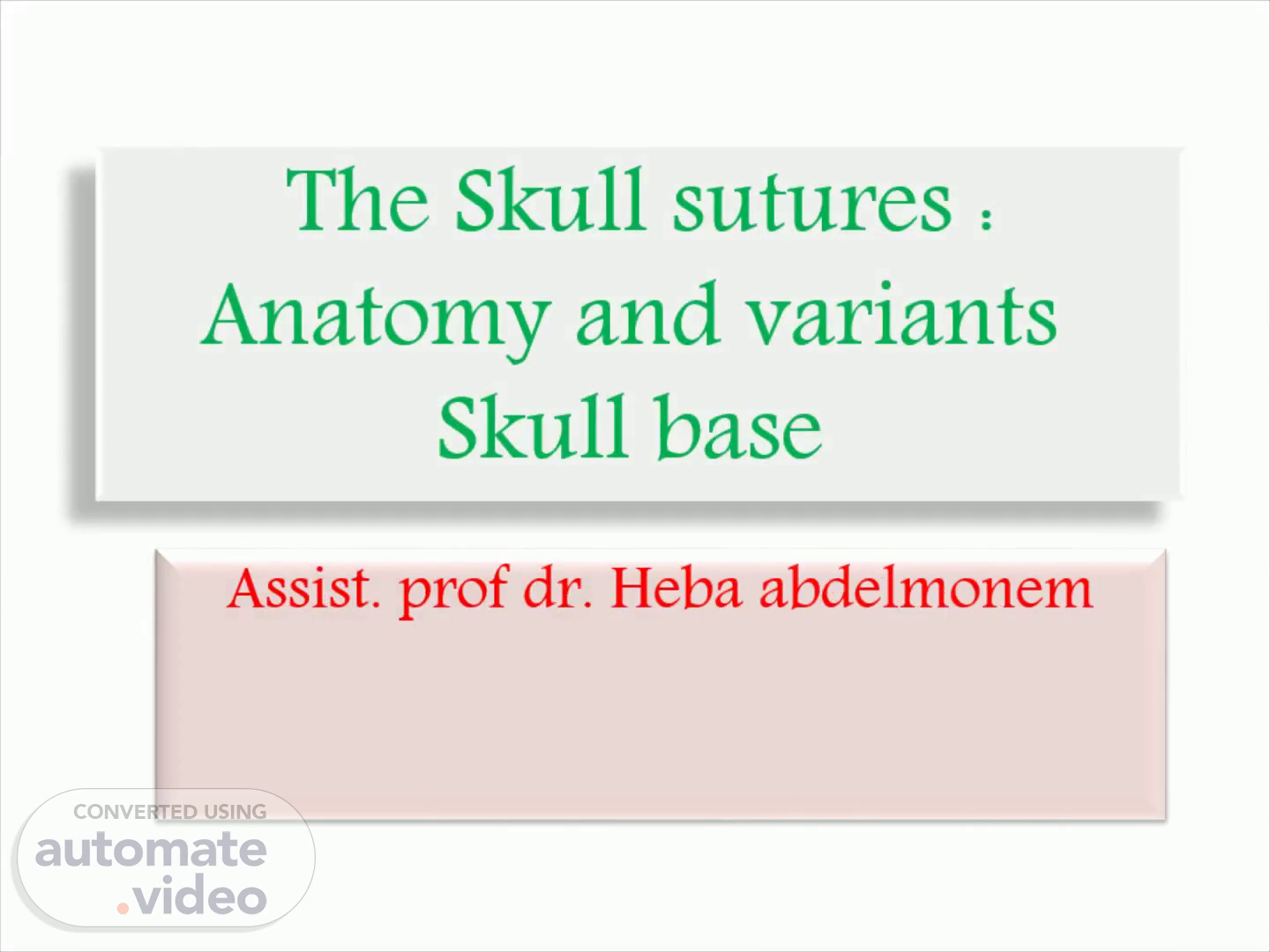
The Skull sutures : Anatomy and variants Skull base
Scene 1 (0s)
The Skull sutures : Anatomy and variants Skull base.
Scene 2 (8s)
Skull bones and sutures. The brain is located inside the cranial vault, a space formed by bones of the skull and skull base. Everything inside the cranial vault is 'intra-cranial ' and everything outside is ' extra-cranial '. Bones of the skull and skull base( frontal, parietal, occipital, ethmoid , sphenoid and temporal bones ) - all ossify separately and gradually become united at the skull sutures . The skull has inner and outer tables of cortical bone with central cancellous bone called 'diploe '. The frontal, parietal, temporal and sphenoid bones unite at the 'pterion ' - the thinnest part of the skull The middle meningeal artery runs in a groove on the inner table of the skull in this area ..
Scene 3 (39s)
The skull in lateral view Frontal Ethmoid Maxilla Mental utur• temporal lims Parietal Zygomatic bone Mandble Zywnatic arch Mandibular angle Occipital suture EOustic meatus suture Mastoid Styloid.
Scene 4 (46s)
Pediatric skull. Sutures are a type of fibrous joint that occurs only in the skull. Synchondroses , which are also found in the skull, are a type of hyaline cartilage joint. In patients up to 4 years of age ( ie , neonates to toddlers), these sutures and synchondroses undergo significant anatomic and morphologic changes. The large sutures—the sagittal, coronal, lambdoid , and squamosal sutures —are seen in all infants (<1 year of age) and toddlers (aged 1–4 years) and persist into adulthood . Premature fusion could happen in all of these sutures. This is known as craniosynostosis that results in irregularly shaped cranium..
Scene 5 (1m 14s)
Expected skull sutures fusion time. 3 months of age, and it should close in nearly all patients by 9 months metopic suture typically closes by 6 years of age but can take as long as 10 years sphenosquamosal suture 15 years of age sphenofrontal 16 years of age occipitomastoid sutures.
Scene 6 (1m 29s)
Expected skull sutures fusion time. 22 years of age sagittal suture around 24 years coronal suture around 26 years lambdoid 60 years Tempro-quamosal sutures.
Scene 7 (1m 40s)
Expected skull sutures fusion time. 4 years of age Innominate suture 12 years of age intraoccipital synchondroses 18 years of age spheno -occipital synchondroses.
Scene 8 (1m 50s)
Technique. One-millimeter-thick images reconstructed at 1-mm intervals by using a bone algorith m ” for axial and multiplanar imaging. And for addressing 3D images, obtain additional thicker (2-mm) bone algorithm images reconstructed at a narrower interval (0.5 mm )..
Scene 9 (2m 4s)
What is the difference between slice thickness and slice interval?.
Scene 10 (2m 27s)
3D shaded-surface VR CT image of the skull. Such images can be used to obtain a quick overview of cranial sutures, thereby helping identify asymmetry and determine morphologic features that may be indicative of An abnormality..
Scene 11 (2m 40s)
Metopic suture. Usually closes 6-9 months In some cases, the metopic suture persists metopism or sutura frontalis persistens.
Scene 12 (2m 53s)
Nonclosure of the metopic suture ( sutura frontalis persistens ) in a 4-year-old child..
Scene 13 (3m 9s)
Sagittal Suture. The sagittal suture intersects with the coronal suture anteriorly, at the anatomic landmark known as the bregma The sagittal suture is the suture most commonly involved in craniosynostosis The average width of the sagittal suture at birth is 5.0 mm, narrowing significantly to 2.4 mm by 1 month of age and narrowing further over time.
Scene 14 (3m 28s)
Coronal Suture. Its average width at birth is 2.5 mm , narrowing significantly to 1.3 by one month of age.
Scene 15 (3m 42s)
Squamosal Suture. the temporosquamosal suture (horizontally oriented red line) and the sphenosquamosal suture (vertically oriented red line ). The s phenosquamosal suture, which courses inferiorly from the pterion and separates the sphenoid bone from the squama of the temporal bone, is often mistaken for a skull base fracture because of its location..
Scene 16 (4m 2s)
abstract. The t emporosquamosal suture, often can be visualized at two points on the right side and two points on the left side ( black arrows ), This is due to the curved plane of the temporosquamosal suture, which may be intersected twice on an axial image. The lambdoid sutures (white arrows) act as useful posterior reference points. The sphenofrontal sutures (arrowheads ) are seen anteriorly.